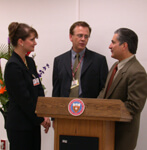
San Antonio (August 3, 2004) – The dental diagnostic science division of The University of Texas Health Science Center at San Antonio hosted an open house July 20 in honor of the new departmental research laboratory dedicated to oral cancer research. The new lab is located in Room 2.580U in the Dental School.
The 1,975-square-foot facility, which has recently been redesigned and equipped with cutting edge technology, will serve as infrastructure for the translational research in oral cancer being conducted by Martin Thornhill, B.D.S., Ph.D., professor and chairman of dental diagnostic science, and his team of researchers.
Oral cancer is the largest division of cancers that fall into the head and neck cancer category. Common names for it include mouth cancer, tongue cancer and throat cancer.
“Roughly one American will die of oral cancer every hour, 24 hours a day, despite cancer advancement,” said Silvana Papagerakis, M.D., Ph.D., assistant professor of dental diagnostic science. “Over the past 50 years there has been no improvement in the survival rate of oral cancer, mainly due to the high risk of cancer metastasis.”
More than 30,000 Americans will be diagnosed with oral or pharyngeal cancer this year. Of those 30,000 newly diagnosed patients, only half will be alive in five years, Dr. Papagerakis said.
By studying the mechanisms that govern tumor metastasis through the blood and lymphatic vessels using a specialized image analysis system, researchers hope to identify valuable markers that could help predict the risk of metastasis for any oral tumor. These lab developments will soon be incorporated into a clinical study that has the ultimate goal of improving treatment and outcome of oral cancer.
If oral cancer is caught early, then there is an 80 percent chance of survival, Dr. Papagerakis said. Health Science Center researchers hope to give clinicians markers and indicators that will help identify oral cancer earlier. Oral cancer patients quality of life can also be affected as it becomes difficult for them to breath, eat and socialize.
“We want to provide patients with a better life and a better chance of survival,” Dr. Papagerakis said.
Dental diagnostic science researchers are working with ear, nose and throat (ENT), and pathology physicians to enroll patients with oral cancer into their study. Researchers will follow the patient’s progress over the next five years.

